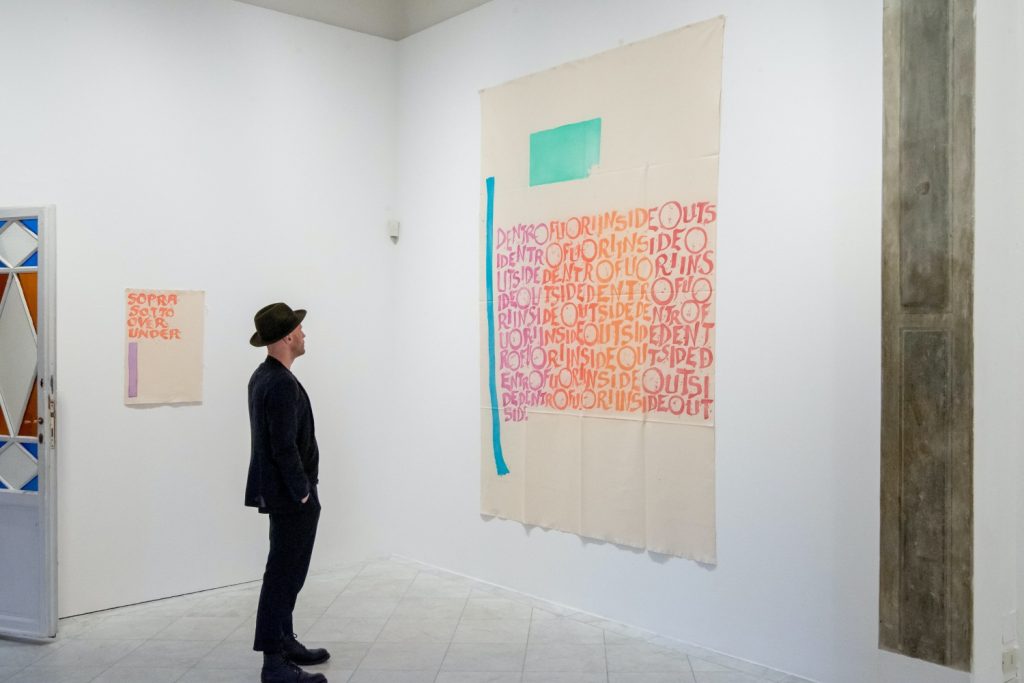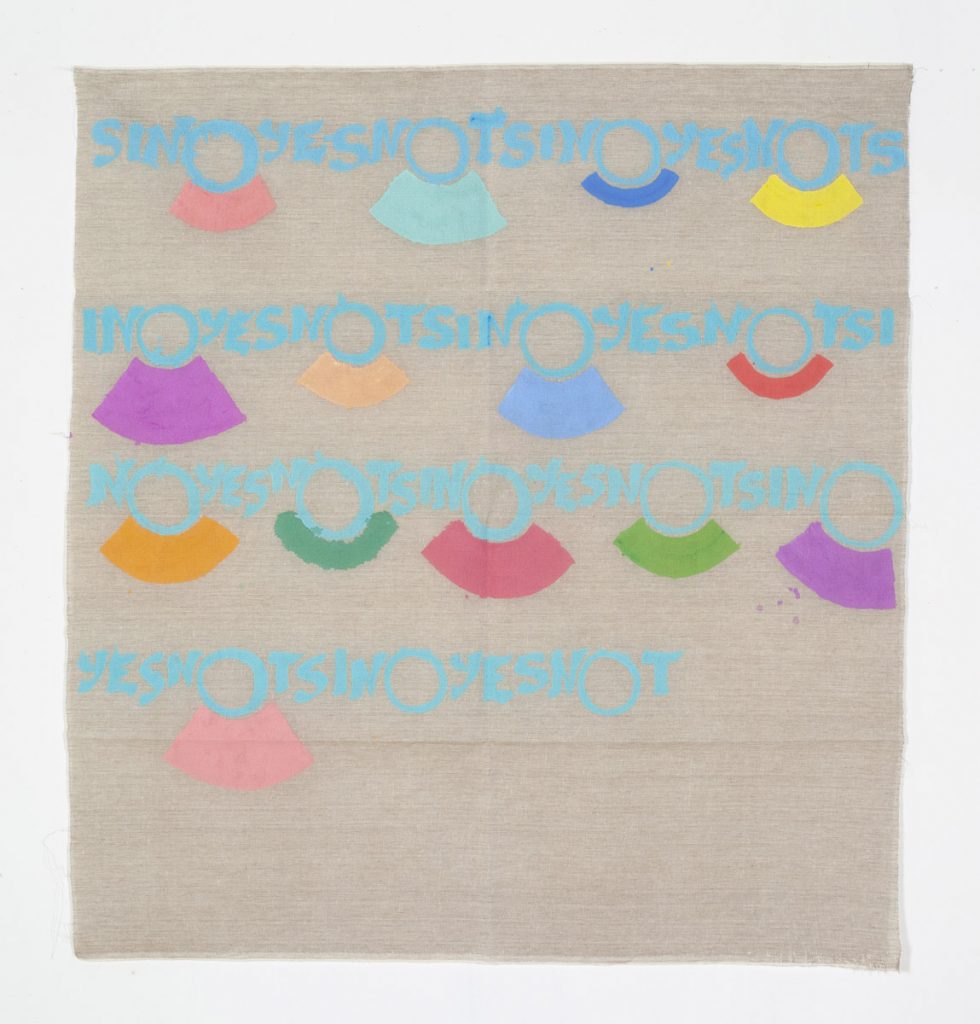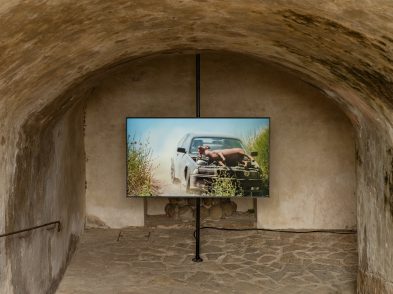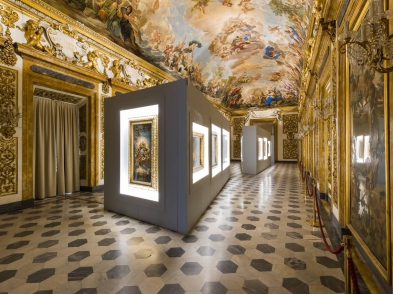In 1977, the last time Giorgio Griffa exhibited in Florence, the Turin-based painter was barely known outside Italy, but highly esteemed by avant-garde artists at home. Now critically re-evaluated, he has become celebrated across Europe and in the US as a significant figure in the generation that revolutionised western culture around 1968. Griffa has already shown this year in New York, Berlin, Madrid, Rome and at the Pompidou Centre in Paris. Only the outside world has changed. As the new exhibition of recent paintings at Villa Romana demonstrates, Griffa has patiently and creatively pursued the same line of enquiry for over 50 years. His work has always reached beyond its ordered surface of intuitive marks and exuberant colours to question the medium’s relationship with knowledge.
“Painting has its own identity,” insists Giorgio Griffa, an artist who evades categorisation. Unlike other painters, in the late 1960s he shared ideas about autonomous properties inherent in materials with the object makers who defined Arte Povera. Through changing critical and commercial fortunes, including times when painting was out of fashion and the market drifted away, he kept on painting and inventing (and working as a lawyer), building an unusually consistent body of work. It had affinities with minimalism and conceptual art, but was neither of those approaches. Griffa also denies being an abstract artist, viewing his imagery as a synthesis of current but transitory reality. Many observers regard him as unique.

Perhaps the boldest characteristic of his painting is its materiality. Canvases are neither stretched, nor framed, but tacked directly onto the wall with simple nails spaced regularly along its top edge. Moreover, threads fall from the unfinished edges of these drapes of linen or hessian, making the viewer aware of its density and natural colour. Both features become integral to the composition of weave because Griffa paints straight onto the raw material. So are the folds that crease the paintings in half or into physical grids. They contribute to the sensation that the work is temporary or provisional. When this show ends, the paintings are folded and shelved, like laundry, in a detail that is both practical and a reminder of that canvas is primarily an everyday textile, the product of time and labour.
Indeed, all the materials he uses have their independent lives. No mark left by the brush on the canvas appears to be more important than another, an equality of being that extends to the artist himself. He is the instrument which applies pigment to the brush that moves across the canvas, which absorbs the paint in a way the artist cannot control, so that the edges of his strokes splay into weave or spot the surface to assume an identity of their own. These incidents are only partly aesthetic: they record action, too. Light is materialised in those marks, reflecting back from the surface to modify colour tones as its intensity varies, making the painting a temporal thing.
Griffa celebrates pigment for its mutable materiality. Pigment forms imagery in bright, clear tones, intermediate hues between the bolder primaries he largely avoids. The artist’s choices are influenced by his admiration for the radiant palette of Matisse, for instance, and for subtle translucent shades of Renaissance frescoes. He rejected oil as his medium many years ago and turned to tempera, the natural pigment of the Middle Ages. Now he uses acrylic paint, often thinned to the consistency of watercolour in violet and magenta, lilacs, greens, periwinkle blues, salmon pink and lime green. From time to time, darker reds and blue appear to “lower” the tone from the prevalence of “cool”, giving his painting “a capacity not inherent in it by nature, but made natural to it through man’s efforts”.
This method of working makes demands: mistakes cannot be corrected once the canvas is stained, which the viewer becomes aware of by looking. Another quality is also apparent: the Zen-like concentration ingrained in each piece. Griffa discovered Buddhist philosophy as a young man and his work seems attuned to a world outside his own feelings and emotions. His contemporary Giulio Paolini once said that “to be authentic, a work of art must forget about its author,” and Griffa follows that advice.
Like expressionist Jackson Pollock in the 1950s, he works with the canvas spread horizontally on the floor to involve his body intuitively in the composition of the image, but the outcome is entirely different. The viewer feels drawn into the nexus of artist, brush, paint and surface to retrace the orderly movement of Griffa’s marks across the canvas from the left margin, acknowledging “no longer the time of the clock, but the internal time of the work”.

For Griffa, rhythm exists at the core of experience. “Fundamentally,” he once said, “music, poetry, and painting have all worked with the first element of human knowledge, which is rhythm: the rhythm of sowing and harvesting, the rhythm of the sun, of day and night.” The dynamic patterns and cadences that pulse within each painting at Villa Romana have evolved from the simple unadorned line of his earliest non-figurative paintings, which reached horizontally across the canvas before abruptly halting to leave most of the canvas untouched. Unpainted areas remain critical to the compositional thrust of his work, which, in the 1980s, introduced sinuous and undulating lines, semi-circles and arabesques, and then numbers followed by letters a decade later. The effect is literary, like the free verse and dynamic lyricism of Ezra Pound, a favourite of Griffa’s. It is decorative, a term Griffa accepts as one of many parallel interpretations that eagerly dissolve traditional prejudices in art, like the distinctions of “high” and “low” intent.
Italo Calvino, another writer this painter admires, once said that, “The struggle of literature is in fact a struggle to escape from the confines of language; it stretches out from the utmost limits of what can be said; what stirs literature is the call and attraction of what is not in the dictionary.” In a sense, Griffa takes up that struggle. His paintings place the viewer on the threshold of awareness: that the scope of knowledge available to mankind is forever increasing.
“In the first half of the last century,” he says, “there was an incredible transformation in human knowledge, largely brought about through the study of physics, which only scientists really understood, but which we are now starting to become more aware of.” Concepts of time-space mathematics and particle physics have informed his thinking in recent decades; the Golden Ratio fascinates him. Colour generate spatial effects, while words turn somersaults on the surface with contradictory meanings or suggest an encrypted code.
Yet his canvases do not overwhelm. “Complex expression does not convey nuanced thought,” he points out and somehow Griffa makes every possibility appear within grasp. Calvino’s observation, “A classic is a book that has never finished saying what it has to say,” equally applies to Griffa’s painting.
Giorgio Griffa exhibition at Villa Romana
See Giorgio Griffa: Unitiseparati at Villa Romana, via Senese 68.
Open now until September 16.
For more information and booking, see the venue website.







